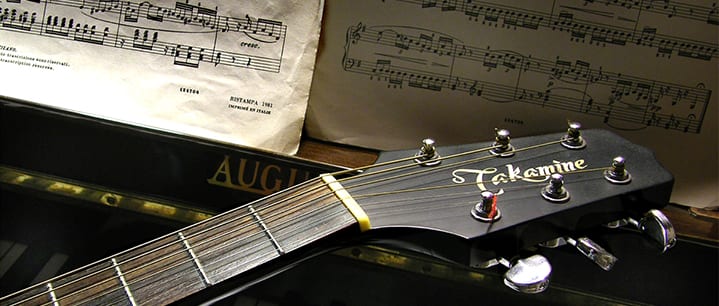What are the “keys” to identifying different key signatures? Read on for some great tips from Tucson, AZ teacher Lourdes C…
Even if you’re a beginner, understanding key signatures is a critical part of reading music. A key signature is a set of sharps or flats at the beginning of a song that appears after the clef and before the time signature.
This symbol indicates which piano keys will be sharp or flat for the rest of the song. In other words, the key signature determines the home tonic note and chord of a song, making it one of the most important aspects to identify.
With that being said, memorizing all key signatures can be daunting and seem impossible at first. However, there are some tricks that you can use in order to make this task less daunting. Before we get into those tricks, let’s first review some basics.
What Are Key Signatures?
In music, a key signature is a set of sharp or flat symbols placed on the staff at the beginning of a song:
- Key signatures are used to indicate which notes will be sharp or flat for the rest of the song. Each key signature has a specific order and number of sharps or flats, which corresponds to the major or minor scale associated with that key. For example, the key of C has no sharps or flats, while the key of F has one flat.
- Key signatures can also be complex, with multiple sharps or flats.
- The key signature is an important element of musical composition, as it helps to establish the tonality of a piece.
- When combined with other musical elements, such as chord progressions and melodic lines, the key signature can help to create a unique sound for a song.
Ready to learn more about key signatures? Sign up for music lessons for your favorite instrument – and watch helpful online videos like the one below:
https://www.youtube.com/watch?v=VFFrxevIgBA
What Are the 15 Different Key Signatures?
There are a total of 15 different key signatures, each with a different number of flats or sharps. The key signature determines the notes that will be sharp or flat for the rest of the song.
For example, in minor key signatures, the third, sixth, and seventh notes of the scale are flat. In a major key signature, the third, sixth, and seventh notes are sharp. There are also “mixed” key signatures, which have both sharps and flats.
One of the most common key signatures is E minor key signature, which has three flats. Another common key signature is F major key signature, which has one flat. Some other common key signatures are:
- A minor key signature
- B minor key signature
- D major key signature
- G major key signature
Key signatures can also be written with accidentals, which are symbols that indicate whether a note should be sharp or flat. Accidentals can be placed next to any note in a song, regardless of the key signature. This allows for more flexibility in creating chords and melodies.
How Do You Identify Key Signatures?
Key signatures can be tricky to identify, but there are a few things to look for that can help.
First, look at the very first note of the song. If it is a sharp or a flat, then that note is likely to be part of the key signature.
Next, look for any other sharp or flat symbols that appear throughout the song. These notes are also likely to be part of the key signature.
Finally, pay attention to the overall sound of the song. If it has a lot of sharps or flats, then those are likely to be part of the key signature as well. With a little practice, you’ll be able to identify key signatures with ease!
Key Signatures at a Glance: Helpful Key Signature Chart
In reading music, there are a few things that give musicians the biggest headaches. One major migraine-maker is determining keys from the key signature and then remembering the order of sharps and flats. This chart gives musicians a quick way to help with identifying key signatures.
|
Major sharps: the name of the key can be found at 1 semitone above the last sharp. |
Minor sharps: the name of the key can be found at 2 semitones below the last sharp. |
|
C has no accidentals |
A has no accidentals |
|
G: F# + 1 semitone = G… |
E: F# – 2 semitones = E… |
|
D: F#, C# |
B: F#, C# |
|
A: F#, C#, G# |
F#: F#, C#, G# |
|
E: F#, C#, G#, D# |
C#: F#, C#, G#, D# |
|
B: F#, C#, G#, D#, A# |
G#: F#, C#, G#, D#, A# |
|
F#: F#, C#, G#, D#, A#, E# |
D#: F#, C#, G#, D# A#, E# |
|
C#: F#, C#, G#, D#, A#, E#, B# |
A#: F#, C#, G#, D#, A#, E#, B# |
|
Major flats: the name of the key can be found at 7 semitones above the last flat. |
Minor flats: the name of the key can be found at 4 semitones above the last flat. |
|
F: Bb + 7 semitones = F… |
D: Bb + 4 semitones = D… |
|
Bb: Bb, Eb |
G: Bb, Eb |
|
Eb: Bb, Eb, Ab |
C: Bb, Eb, Ab |
|
Ab: Bb, Eb, Ab, Db |
F: Bb, Eb, Ab, Db |
|
Db: Bb, Eb, Ab, Db, Gb |
Bb: Bb, Eb, Ab, Db, Gb |
|
Gb: Bb, Eb, Ab, Db, Gb, Cb |
Eb: Bb, Eb, Ab, Db, Gb, Cb |
|
Cb: Bb, Eb, Ab, Db, Gb, Cb, Fb |
Ab: Bb, Eb, Ab, Db, Gb, Cb, Fb |
Written Order of Accidentals and Example Key Signatures
 Let’s work on identifying key signatures by looking at the image above. The last flat in this case is F (Fb is E, in enharmonic spelling). From Fb, count up 7 semitones (half-steps) and keep the enharmonic spellings for E and B (Fb and Cb, respectively): Fb -F-Gb-G-Ab-A-Bb-Cb (B) – key of Cb major. Count four semitones up and you get Ab minor, the relative minor of Cb. Even if you don’t know the mode, either major or minor, by using this key signature method, you will always be able to find the major and relative minor for any signature you encounter.
Let’s work on identifying key signatures by looking at the image above. The last flat in this case is F (Fb is E, in enharmonic spelling). From Fb, count up 7 semitones (half-steps) and keep the enharmonic spellings for E and B (Fb and Cb, respectively): Fb -F-Gb-G-Ab-A-Bb-Cb (B) – key of Cb major. Count four semitones up and you get Ab minor, the relative minor of Cb. Even if you don’t know the mode, either major or minor, by using this key signature method, you will always be able to find the major and relative minor for any signature you encounter.
This next key signature has one accidental. Avoid assuming that this is Bb major or minor. This is actually Fb major. Fb minor is actually E minor, which is a sharp key. This method will help you work through the Circle of Fifths and understand the relationship between tonal arrangements in keys.
Other Problems to Avoid
Accidentals (sharps and flats symbols) are written in descending order from top right to bottom left on the staff. So, knowing the last flat or sharp requires that you remember the order of sharps and flats, because on the staff, the last accidental may appear higher than the first, which can trick you into thinking it’s the first accidental. This is Bb major, as an example:
Mnemonic for the Order of Sharp and Flats
The order of flats is BEADGCF (“bead” – gcf). A good mnemonic is “bead the G clef from middle C to the F clef”. If you can remember that, just know that for sharps, it will be backwards: FCGDAEB. If you remember only that mnemonic and the counts in the chart above, you’ll always be in the right order and you can identify keys by their signatures alone with just a little practice.
Key Signatures in Music – Practice Makes Perfect!
Mastering your ability to identify key signatures is an important part of reading music–the earlier you start learning how to do it correctly, the better! With these tips and tricks under your belt, you’ll be well on your way to becoming a pro at identifying any key signature thrown your way!
To practice, find any good graphic image for the Circle of Fifths and try this for yourself! Happy music-making!
 Lourdes C. teaches various music subjects and tutors in Tucson, AZ. Her doctorate is in Applied Linguistics and American Indian Studies. She has been an instructor and tutor for over 20 years for academics, research methods, languages and literature, and music as well. Book in-person or online lessons with Lourdes here!
Lourdes C. teaches various music subjects and tutors in Tucson, AZ. Her doctorate is in Applied Linguistics and American Indian Studies. She has been an instructor and tutor for over 20 years for academics, research methods, languages and literature, and music as well. Book in-person or online lessons with Lourdes here!
Photo by angelocesare
Suzy S.




